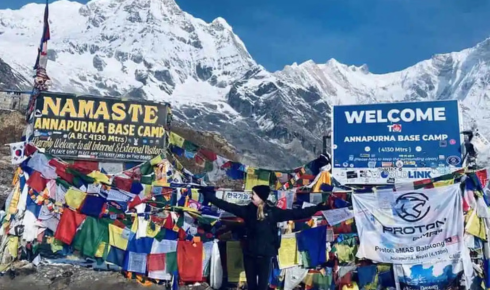Budgeting for the Trek to Annapurna Base Camp is a vital part of scheduling your journey to Nepal’s famous mountain range. Knowing the costs enables you to prepare both financially, so that you will not be surprised, but also so that you can enjoy the trek without stress. The sum total can vary according to the permits, the accommodation and food, travel, gear, and optional services like guides or porters. This estimation shows a good perspective for business projects and a detailed description to organize your budget.
One early cost to be aware of is permitting. To get permissions for trekking in the Annapurna Conservation Area, an Annapurna Conservation Area Permit(ACAP) and a Trekkers’ Information Management System (TIMS) card are required. The total cost of the two permits is about $40-50USD all altogether. They are mandatory and they support efforts to protect the environment and safety. Permits Kathmandu, 198 page 18013509689, 10 AM, 4/30/14. The visa for residents, though, the health cards, the permissions, even the fees, all come from Nepal. It is easy to get the necessary permits through the proper channels or your trekking agency.
Accommodation prices differ as you travel along the trail, with teahouses providing basic lodgings that average between $5 and $15 per night. At higher altitudes, logistics make providing for lodges more difficult, and prices tend to go up. Simple as they are, teahouses offer an informal atmosphere to shelter and eat, and have a good social background for travelers. You can budget to spend about $10 per night, on average.
Another factor to keep in mind is food cost. Teahouses offer a variety of local and international fare, and meals generally cost between $3 and $10 each. Dal bhat, a typical Nepali meal of rice and lentils, is cheap and filling. Bringing energy bars or snacks is a good idea for long trekking days. Hydration is key, so consider the cost of water purification tablets or bottled water (especially at higher elevations).
Includes the cost of transportation from Kathmandu or Pokhara to the start of your trek and return from the end of your trek. Local buses are cheaper, but less comfortable and slower; they run for a few bucks. Private jeeps or taxis carry passengers more quickly and comfortably, but might cost $50 or more, depending on distance and negotiating capabilities.
It is optional to hire a guide and a porter, but having one or two persons along with you could certainly enhance your safety and your overall trekking experience, should this be your first time in the region. Guides generally charge around $25–$35 a day, with porters running $15–$25 per day. These providers provide more than just a physical reprieve; they bring your trek to life with local knowledge and cultural interpretation. Oh, and don’t forget to include tipping in your budget, because it’s customary.
Other miscellaneous costs could be purchasing or renting trekking equipment, travel insurance with high-altitude coverage, and unforeseen circumstances such as medical emergencies or gear repairs. These can certainly eat into your funds, but are essential to a safe and fun trek.
In conclusion, budgeting for the Annapurna Base Camp trek cannot be a precise calculation, as you have to be approximate for fixed and variable costs. If you plan your permits, accommodation, food, transport, guides, and gear, it will make for an easy trek. With good budget handling, you will enjoy the stunning views of the mountains and of the cultural highlights that the Annapurna Base Camp trek is without a doubt prepared to offer.
Overview on how much is the required budget for the Annapurna Base Camp Trek?
Annapurna Base Camp Trek Budgeting is a big part of planning for the Annapurna Base Camp trek, and understanding all costs will make sure you don’t have any surprises along the way. The ABC trek, famed for its impressive panoramas and vibrant local culture, necessitates costs over and above travel. From permits to places to stay, food, transport, and optional boat guides and porters, understanding what your money gets you helps you plan more effectively. A well-executed budget will also help you set aside money for emergencies, gear, and personal expenses. Though the total cost can be different for you based on the type of trekking you prefer, the season, and the services you select, it’s better to at least know such an in-depth description for enjoying a peaceful trek. In this article, we’ll break down each cost element to give you an accurate idea so you can budget and get down to the best bit: trekking in the Himalayas!
Annapurna Base Camp Trek Permit Prices?
One of the fixed expenses you need to keep in mind while trekking to Annapurna Base Camp is the permit charge. Trekkers require two main permits: the Annapurna Conservation Area Permit (ACAP) and the Trekkers’ Information Management System (TIMS) card. The ACAP is an environmental and community welfare contingency plan in the Annapurna Region, and the TIMS card is a means by which authorities can keep thorough tabs on trekkers for safety. Together, these permits generally come out to a total of around $40 or USD 50, depending on your nationality and where you buy them. Permits can be bought in Kathmandu or Pokhara, or from a trekking agency. You will need to have these permits with you while you are trekking, as checkpoints will constantly be checking. The fees help for sustainable tourism, ensure upkeep of the trails, and support local lives. Planning for the cost of permits in advance can streamline trekking logistics and keep you on the right side of Nepal.
Trail Living – Accommodation Costs
Lodging on the ABC Trek is mostly in teahouses, the simple lodges operated by local families. The cost for a room is usually between $5 and $15 a night. The price tends to go up with elevation, since it’s more difficult to fill higher-altitude lodges. Rooms in most of the teahouses will be simple with a bed and blanket, and heating is rare, so it would be wise to bring a warm sleeping bag. Accommodations are simple, but guests get a taste of local life and opportunities to socialize with other trekkers. You’ll pay around $10 a night if you’re on a budget. In the high seasons, booking is recommended for rooms. Despite being rudimentary, teahouses are a source of rest and sustenance; therefore are an important part of your trekking budget and experience.
Cost for Food & Drink on the Trek
Food costs are another key aspect of your ABC trek budget. Teahouses serve a combination of Nepali and Western meals, and meals are generally priced between $3 and $10 each. For a good, hearty and cheap feed, the traditional dal bhat set — rice, lentils and some bland vegetable side at most inns – is favoured by most. Western dishes like pasta, noodles, and soup meals will also cost slightly more, but are served on the way. Trekking is hard work, and it’s important to stay well fed, so budget for three meals a day and snacks. Hiking with energy bars, or trail mix, for long days when you’re not sure when you’ll have your next meal. It is better to purify water with either tablets or filters to prevent illness, but prices for bottled or filtered water range between $1 and $3 per litre. Staying hydrated and well-fueled helps sustain your energy levels and supports your immune system on the trail.
Return Transport to and from the Trek
Transport to/from the start and end of the Annapurna Base Camp Hike, which costs between budget and deluxe travel styles. The typical itinerary for most trekkers is to fly into Kathmandu, Nepal’s capital city, and travel from there to the city of Pokhara, which serves as a gateway to the Annapurna region. The Kathmandu-Pokhara distance can be traveled by local bus, jeep, or domestic flight. Buses are cheaper, running about $7 to $10, but taking six to eight hours. Faster trips but more expensively, $70 to $100, can be arranged with private jeeps or taxis. Local buses and jeeps, for a few dollars, will take you from Pokhara to either Nayapul or Bhulbhule, from where you can access the trailhead. For some trekkers, the more convenient private vehicles are rented. Budgeting for transport will be important since punctuality is needed to ensure arriving and departing on time, which is essential in organizing the rest of your trek schedule.
How much does it cost to hike Annapurna Base Camp?
The total cost of hiking the Annapurna Base Camp Trekking typically ranges from $600 to USD 1,200 per person for a 7–12 day trek, depending on your travel style (budget vs. guided vs. luxury). This estimate includes:
- Permits: ~$40–50 USD (ACAP + TIMS)
- Accommodation: ~$7–15 per night (teahouses)
- Meals: ~$20–30 per day
- Transport (Kathmandu–Pokhara–Trek start): ~$30–100
- Guide (optional): ~$25–35 per day
- Porter (optional): ~$15–25 per day
- Misc. expenses: Wi-Fi, hot showers, snacks, charging, tips, etc.
Budget travelers going independently can manage for less (~$600), while trekkers hiring guides/porters or using agencies may spend more.
How much is a guide for Annapurna Base Camp?
A licensed guide for the Annapurna Trek costs about $25 to USD 35 per day. This usually includes:
- Their daily wage
- Food and accommodation
- Assistance with permits and logistics
ABC Trekking Hiring a guide adds value by improving safety, offering cultural insights, and managing navigation. Most trekkers also tip their guide an additional 10–15% at the end of the trek. Some travel agencies offer guide + package deals, which may include permits, transport, and lodging.
How much does it cost to go to ABC?
The total cost to go to ABC (Annapurna Base Camp) depends on your trekking style. Here’s a general breakdown:
- Independent Budget Trekker: ~$600–$800
- With Guide/Porter (mid-range): ~$800–$1,200
- Fully organized package tour: ~$1,200–$1,800
Cost factors include:
- Transport (bus, flight to Pokhara)
- Permits (ACAP + TIMS)
- Daily expenses (food, lodging, internet, charging)
- Equipment rental or purchase
- Optional: travel insurance, guide/porter, tips
Some trekkers manage very economically, while others prefer comfort and safety with support staff and pre-booked services.
How much cash do I need for the Annapurna Circuit?
For the Annapurna Sanctuary Trek, you’ll generally need $700 to USD 1,300, depending on your preferences and length of trek (typically 12–20 days).
Breakdown:
- Permits (ACAP + TIMS): ~$40–50
- Food and accommodation: ~$25–35 per day
- Transport (to/from trailhead): ~$30–100
- Guide (optional): ~$25–35/day
- Porter (optional): ~$15–25/day
- Miscellaneous (snacks, Wi-Fi, showers, tips): ~$100–200
If going independently, bring enough cash (Nepali rupees) before the trek—ATMs are available in Besisahar, but not along most of the trail. Pokhara or Kathmandu are ideal for withdrawing cash.

